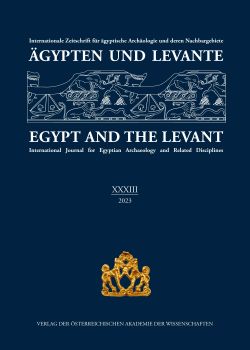Manfred BIETAK (Editor in Chief) - Ernst Czerny - Christiana Köhler - Nadine Moeller - Karol Myśliwiec (Eds.)
Ägypten und Levante XXXIII
Egypt and the Levant XXXIII
Internationale Zeitschrift für ägyptische Archäologie und deren Nachbargebiete
International Journal for Egyptian Archaeology and Related Disciplines
Francisco L. Borrego Gallardo
S. 179 - 199
doi:
10.1553/AEundL33s179
Verlag der Österreichischen Akademie der Wissenschaften
doi:
10.1553/AEundL33s179
Abstract:
Royal funerary complexes in Old Kingdom Egypt are multifaceted, meaning-laden spaces where, from the early Fourth Dynasty, large areas of wall reliefs were devoted to scenes featuring rows of personifications representing estates, provinces, regions, and elements of the Egyptian landscape, offering food and other items to the deceased king. While a widespread interpretation sees these scenes as a collective contribution from the entire country to sustain the monarch in the afterlife, it proves too general and warrants a more detailed explanation. Considering the polysemy of these spaces, two complementary meanings emerge. One is political, revealing the king’s dominion over the territory through the imposition of administrative organization and its appropriation via taxation in kind. The other is funerary, guaranteeing the king’s royal status postmortem, affirming his control of the ordered world, and securing the supply of offerings for his afterlife existence. Further evidence from the Third Millennium BCE supports this interpretation, illustrating the appropriation, anthropization and personification of the Egyptian landscape. This deliberate control and ordering of the environment facilitate the transformation of nature into habitat and nourishment, and nourishment into taxes and offerings perpetually owned and consumed by the deceased king.
Ancient Egypt, Old Kingdom, royal funerary complexes, offering, landscape, personification
Published Online:
2024/02/28 15:23:11
Object Identifier:
0xc1aa5576 0x003ed9c2
Rights:All rights reserved.For questions regarding copyright and copies please contact us by email.
Die Zeitschrift Ägypten und Levante wurde im Jahr 1990 von Manfred Bietak begründet, um den Forschungen zu den Kulturkontakten zwischen Ägypten und seinen Nachbarländern sowie der ägyptisch-kanaanäischen Hybridkultur, wie sie vor allem bei den österreichischen Ausgrabungen in Tell el-Dab’a zutage trat, eine Publikationsplattform zu bieten. Von Anfang an war die Zeitschrift international und interdisziplinär ausgerichtet. Das Themenfeld geht über die ursprüngliche Kernthematik weit hinaus und umfasst sowohl Vorberichte und Berichte zu archäologischen Grabungen in Ägypten und dem gesamten Vorderen Orient sowie Nubien und dem Sudan, wie auch Artikel zu allen Aspekten der ägyptischen und nahöstlichen Archäologie, Geschichts- und Kulturwissenschaft. Der Fokus liegt auf der pharaonischen Zeit, jedoch sind sowohl Beiträge zur Ur- und Frühgeschichte der genannten Regionen wie auch zur nachpharaonischen Antike möglich. Dazu wird ein weites Feld an naturwissenschaftlichen Themen abgedeckt, von Fragen der C14-Datierung über materialkundliche Untersuchungen bis hin zu archäobotanischen, archäozoologischen und anthropologischen Arbeiten.
Ägypten und Levante erscheint einmal jährlich im Druck und online. Die Redaktion ist bemüht, eingereichte Artikel möglichst zeitnah zu publizieren. Beiträge sind in Deutsch, Englisch oder Französisch einzureichen. Buchbesprechungen und Rezensionen werden nicht publiziert. Alle eingereichten Artikel werden einem internationalen peer-review Verfahren gemäß den Qualitätsstandards der Österreichischen Akademie der Wissenschaften unterzogen.
Egypt and the Levant was founded by Manfred Bietak in 1990 to provide a publication platform for the research on cultural contacts between Egypt and her neighbours. A focus of interest was the Egyptian-Canaanite fusion of cultures, which was mainly encountered at the site of Tell el-Dab’a during the Austrian excavations. From the beginning, the scope of the journal was international and interdisciplinary. The subject area has now been greatly expanded far beyond the original topics. It comprises reports and preliminary reports on archaeological excavations in Egypt and the entire Middle East including the Sudan, as well as articles dealing with all aspects of Egyptian and Near Eastern archaeology, history or cultural history. The main emphasis lays on the pharaonic period, but both contributions to prehistory of the said regions, and post-pharaonic periods may be accepted. In addition, a broad range of scientific topics is covered, including C14-dating, material analyses, archaeobotanical and archaeozoological studies as well as studies in physical anthropology.
Egypt and the Levant is published on an annual basis, both in print and online. Submitted articles are intended to be published in a timely manner. Manuscripts may be submitted in English, German or French. Book reviews are not accepted. All submitted articles are subject to international peer-review according to quality standards of the Austrian Academy of Sciences.



 Home
Home Print
Print
 References
References
 Share
Share
